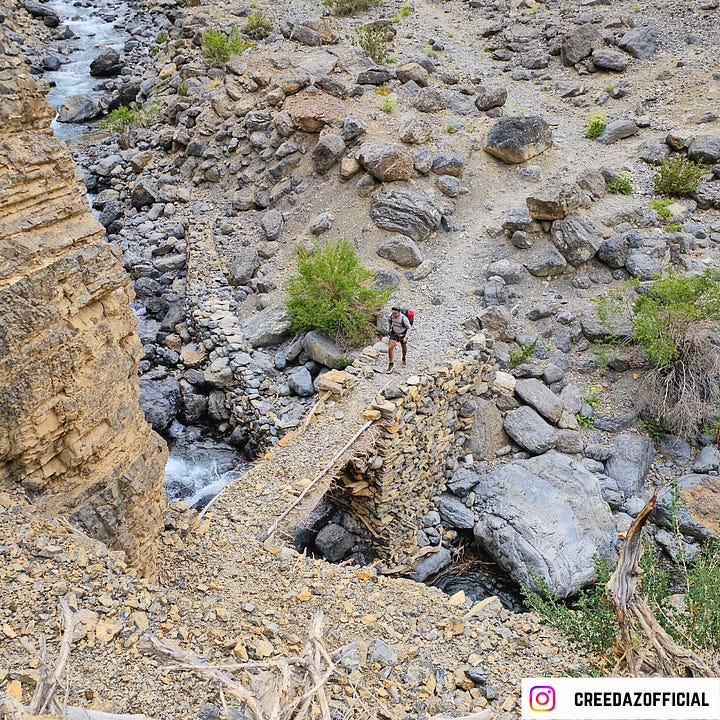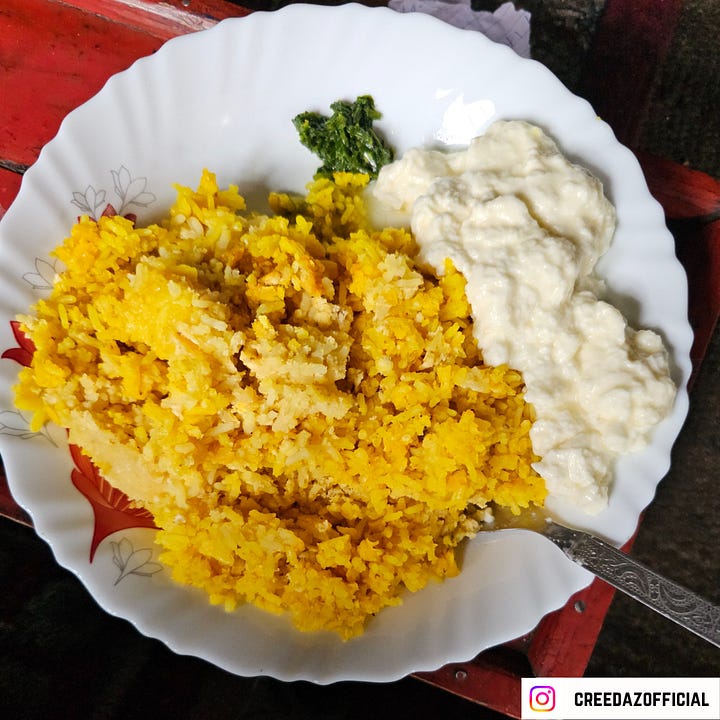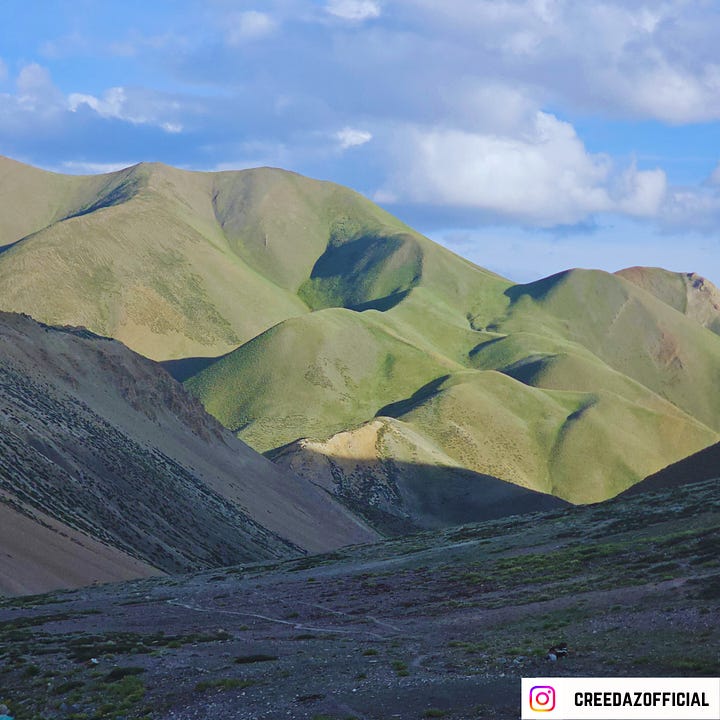23rd July 2024
Route: Tso Tokpu and Niri Chu confluence to Shade village
Distance: 08 km
Elevation gain: 372 m
The village of Shade (Sha-det) became well known to the hiking community after India-in-motion made a beautiful video series on village life in Zanskar. I had a small opportunity to hike to Shade in 2022 when I was doing a motorbike trip in Zanskar in 2022 but, could not execute it due to less time in hand.
On Day 13 of the Skypacking trip, we woke up at 08:00 am as the body needed some rest after doing two big passes the previous day. Pete was still feeling pretty wrecked (as he describes it) from the 33 km distance we did the last day. We thought of skipping breakfast as the village of Shade was just 8 km away.
We wrapped up the campsite and started hiking by 09:00 am. We crossed the bridge over the Tso Tokphu and approached Shade. It was a partly cloudy day. The Niri Chu stream looked big enough and I was anticipating that it could be challenging to cross the stream later in the trip as there was a good volume of water in the river.


The trail to Shade contours through an open scrub—the deserted hamlet of Tantak (4000 m). There is a on old Gompa where people go once a year to worship. While hiking near Tantak if you look carefully you can also spot a big bridge on the Niri Chu at a distance. That bridge connects the trails on both the banks of Niri Chu. From the left bank, the trekking groups with horses hike to Phugtal Gompa and from the trail on the right bank the trail is narrow and is suitable only for humans and not horses.
After hiking for less than 2 hours we came across the junction from where one trail goes to Stongde La (connects Shade and Stongde) and one trail goes to the village of Shade. There is a significant shrine on this junction with trail markers showing the route towards Shade. Stongde La is also a good trail but the month of July will not be suitable due to the high volume of meltwater in the rivers. The ideal window to do Stongde La will be September - October.


The moment we entered the side valley towards Shade the flora along the trail blew our mind. We instantly felt that we were in the Garden of Eden. There was a narrow aqueduct flowing alongside the trail. There were thousands of flowers and the landscape was very green and lively. One could hear humming bees and birds all along the trail.


We finally could see the farmlands of the village of Shade. We had a small interaction with the women working on the farm. There was a beautiful chorten that felt like an entry gate to the village premises. Shade looked beautiful. As we were looking for people to interact with, I came across Mr. Phuntsok Namgyal. He said that there is no homestay in Shade but we can stay in his house for the day. He took us in and gave us some hot tea. Furthermore, he spoke perfect Hindi.
He had served in the Indian army and now is settled in Shade with his wife. It was a very small day for us in terms of hiking distance and elevation gain. However, both me and Pete felt like staying in Shade for the rest of the day. We had long conversations with Namgyal Aacho. We talked about the topics of life in the village in winter, the rural-urban migration, the wildlife and the challenges that they face living at 4000 meters in the pretty remote village.


We had rice and dal for lunch. There was WiFi in Shade and we were able to use WhatsApp. By 05:00 pm, Namgyal Aacho asked me if I would be interested in going to the ‘Doksa’ which is a place some 2 km away from the village where there are female yaks (Demul) and all the women in the village go to the Doksa to milk the Demuls (Female Yaks). I got pretty excited and went along with Aachey to the Doksa. Pete stayed back as he wasn’t feeling great.


On our way to the Doksa, I was able to appreciate the beautiful lush green mountains adjacent to the village of Shade. The experience of sitting and just watching the females of the village tame the Demuls and collect milk was beautiful. They would first try and make the Demul comfortable, they then would sit down and sing or hum a song as they milk the Demuls. There was a small kitchen where they would prepare butter tea. There was also a tarp shelter where there were 2 Nepali boys who were responsible for the safety of the Yaks, demuls and their offspring. They made sure that all the Yaks would graze during the day and come back to the Doksa by dusk.
The whole environment at the Doksa was so warm. It felt like all the women (old and young) enjoyed this time as they talked and laughed at topics that were important to them. They sang and danced on their way to the Doksa. They collected milk in small bottles (2-3 litres). On their way back they would collect Yak dung which acts as fuel to cook food and boil water using the Bokhari (hot furnace).


It was a pretty wholesome day at Shade. It was one of the days when I felt like slowing down. I felt like talking to the locals and asking questions about life in general. We also gathered information about things that the villagers would need. We promised Namgyal aacho to buy a battery for his house since the village runs on solar power.
The plan for Day 14 was to hike towards Ningri after crossing the passes of Gautang La (4880 m) and Lar La (4670 m). However, the next day, Pete felt miserable and had a lot of congestion in his chest. We decided to spend another day in Shade as it might help Pete recover. I finished writing blogs and working on the DIY Trekking Community work using the little Wi-Fi connection that we had.


Tips:
Shade (4000 m) is a perfect stop. There are small day hikes that you can do from Shade. It is pretty much possible to spend 2–3 days in Shade. So if you are into slow-paced hiking and cultural immersions, then Shade is the ideal village.
Only WhatsApp works in Shade. Don’t expect to browse through the internet.
Another small hike to Shade starts from Phugthal Gompa (23 km). Through this trail, one can also hike during winter.
Carry a filter with you. There are no potable water springs on the trail. You can fill one bottle from Tok Phu itself.
If you wish to learn how to execute these treks in a DIY style then check out the DIY Trekking Field Course where I teach all the important modules that can help you become an independent hiker.




Flowers 💐